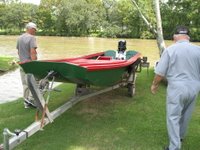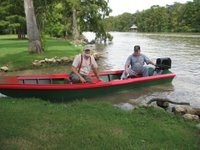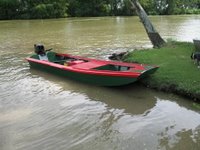Bateau Epilogue
 being functionally complete – it would float and was ready for a motor and pain
being functionally complete – it would float and was ready for a motor and pain t etc. Now the motor has been added and paint has been applied. A number of other things have also been done to the bateau and the included pictures are intended to illustrate that. A contrast between the project boat as completed and this final boat can be seen in the first two pictures. First, the paint. The colors of red and green are traditional colors used to identify boats built by the Couvillier family, and the pattern is also traditional. In the last century, the bottom paint was
t etc. Now the motor has been added and paint has been applied. A number of other things have also been done to the bateau and the included pictures are intended to illustrate that. A contrast between the project boat as completed and this final boat can be seen in the first two pictures. First, the paint. The colors of red and green are traditional colors used to identify boats built by the Couvillier family, and the pattern is also traditional. In the last century, the bottom paint was  originally (in the Old Days) red lead, not oil based enamel paint. This special paint would protect the bottom of the boat from growth of algae that would slow the boat and make the bottom very hard to clean. Red lead, as the name implies, is made from lead and is no longer considered safe for the environment. But in this case the red lead paint is no longer necessary because most of the boats these days aren’t left in the water for extended periods – trailers are the more long term storage choice now.
originally (in the Old Days) red lead, not oil based enamel paint. This special paint would protect the bottom of the boat from growth of algae that would slow the boat and make the bottom very hard to clean. Red lead, as the name implies, is made from lead and is no longer considered safe for the environment. But in this case the red lead paint is no longer necessary because most of the boats these days aren’t left in the water for extended periods – trailers are the more long term storage choice now.The motor that Larry, apprentice and now owner, has put on the boat is a 25 horsepower Mercury. I would have thought a larger motor would have been more tempting, but when this boat runs with that 25, you don’t wish for anything more powerful – it moves at about 35 mph with two big people in it. This is attributed to the design of the boats that Edward builds. Larry has placed an aluminum plate on the sternboard for the motor to sit on. This protects the wood and ma
 kes for a secure seat for the motor.
kes for a secure seat for the motor. Two strips of oak have been added to the top of the gunnels, and one down the side. They run about halfway down the length of the boat. These serve as sacrificial pieces as the boat works as a platform for running hoop nets or trot lines. As they wear away, the small strips can easily be replaced when necessary. The inside of the bow section shows the area you need to stand in when running lines or doing other work at the front of the boat. The
Two strips of oak have been added to the top of the gunnels, and one down the side. They run about halfway down the length of the boat. These serve as sacrificial pieces as the boat works as a platform for running hoop nets or trot lines. As they wear away, the small strips can easily be replaced when necessary. The inside of the bow section shows the area you need to stand in when running lines or doing other work at the front of the boat. The  timbers across the bottom are spaced to allow you to stand between them comfortably. And the deck is the right height to be comfortable for a bait container to be placed there and dipped into 1000+ times a day by a line fisherman. Lots of exercise for the lower back, I guarantee, so it needs to be at the right height.
timbers across the bottom are spaced to allow you to stand between them comfortably. And the deck is the right height to be comfortable for a bait container to be placed there and dipped into 1000+ times a day by a line fisherman. Lots of exercise for the lower back, I guarantee, so it needs to be at the right height.A small seat has been placed in the back for the operator of the motor. It serves as a dry box as well as a seat. Having it small enough to provide room for one person helps
 maintain room for other work-related material that needs to be stored in the back of the boat. Other occupants in the boat would sit forward on the hatch covers.
maintain room for other work-related material that needs to be stored in the back of the boat. Other occupants in the boat would sit forward on the hatch covers.These bulkhead covers, or hatch covers as they are usually called, protect the fish or other cargo being carried in the boat, and many times they are very useful in getting from the back to the front of
 the boat, or vice versa. In rough water it’s good to have something that broad to step on. The rougher it is, the narrower the gunnel seems to be if used for a walkway, and it can get slippery.
the boat, or vice versa. In rough water it’s good to have something that broad to step on. The rougher it is, the narrower the gunnel seems to be if used for a walkway, and it can get slippery. Edward got into the boat and ran it up and down the bayou, and I watched him get that faraway look in his eyes, all kinds of memories going by in front of him, and for the moment passing without a feeling of being over for good. But they are. He will not be able to use this wonderful tool that he has built, as he has done so many times in the past. He knows that he can no longer safely do the work required by a commercial fisherman, but the memories are there as he runs this boat fast down Bayou Teche. He is using this boat to bring back feelings of big fish, of nights fishing deep lines in the channel, of castnets full of bait-sized shad, of sweating as he drove poles to tie his lines to, and so many, many other good memories. He looks at me and says “Now, if we could just go run some lines”.
Edward got into the boat and ran it up and down the bayou, and I watched him get that faraway look in his eyes, all kinds of memories going by in front of him, and for the moment passing without a feeling of being over for good. But they are. He will not be able to use this wonderful tool that he has built, as he has done so many times in the past. He knows that he can no longer safely do the work required by a commercial fisherman, but the memories are there as he runs this boat fast down Bayou Teche. He is using this boat to bring back feelings of big fish, of nights fishing deep lines in the channel, of castnets full of bait-sized shad, of sweating as he drove poles to tie his lines to, and so many, many other good memories. He looks at me and says “Now, if we could just go run some lines”. Lena Mae, Edward’s wife, is shown here in one picture riding in the new boat with Edward. She has always helped make a living for her family in ways that used the Atchafalaya Basin. She ran lines with Edward, ran the motor for him when he needed to work in the front of the boat, helped clean fish sometimes and produced and raised a family in addition to all that. If you ask her why she did it she will tell you that she did it because it had to be done, and she will add that she enjoyed most of it. She’s a good cook too!
Lena Mae, Edward’s wife, is shown here in one picture riding in the new boat with Edward. She has always helped make a living for her family in ways that used the Atchafalaya Basin. She ran lines with Edward, ran the motor for him when he needed to work in the front of the boat, helped clean fish sometimes and produced and raised a family in addition to all that. If you ask her why she did it she will tell you that she did it because it had to be done, and she will add that she enjoyed most of it. She’s a good cook too! Carl Carline is pictured with Edward in several of the pictures. Carl is another person who can claim to be a Basin native. He has roots in houseboat traditions, and his wife Joyce is from Bayou Chene. Carl is also a boatbuilder at the master craftsman level. He builds his own boats mostly, both out of cypress that he pulls out of the Basin himself, and out of aluminum. As a practical thing, metal is so much easier to maintain. But the romance and the warmth and the memories are with the wood.
Carl Carline is pictured with Edward in several of the pictures. Carl is another person who can claim to be a Basin native. He has roots in houseboat traditions, and his wife Joyce is from Bayou Chene. Carl is also a boatbuilder at the master craftsman level. He builds his own boats mostly, both out of cypress that he pulls out of the Basin himself, and out of aluminum. As a practical thing, metal is so much easier to maintain. But the romance and the warmth and the memories are with the wood.
A copy of the full report for the apprenticeship boatbuilding project can be had for the asking. The original was 50 pages long, with 73 pictures and was about 90 Mb in size - way to big to send to anyone. But through the miracle of talented friends, the report is reduced to 1.5 Mb and can be downloaded by most online services. Let me know if anyone would like to have one.
The river is at 2.0 on the Butte La Rose gauge, falling to 1.6 by Monday. The Ohio and Mississippi are generally falling slowly. If the river gets to and stays at 1.8 feet for a little while, we may see those old sunken boats yet. The lowering water allowed me to pull out the skull and jaw of the alligator that disintegrated near the dock. It was bigger than I thought, some teeth are two inches long. Photos to follow when I clean the bones a little.
Rise and Shine, Jim


4 Comments:
Thanks Jim, genuine craftsmanship touches my soul. You've shared a lot of great stuff, lately! And I never knew that crabs and shrimp could travel upstream; fish, eels, and sharks I can understand. But crabs? I never would have guessed it.
It is my pleasure to share it, believe me! Yes, the crabs are our familiar edible saltwater crabs, but the shrimp are freshwater. Thanks for the comment, Bud. Jim
Hi Jim! If you get a chance can you email me at bmolloy@katctc.com. I am a reporter at KATC and have a story idea I was hoping to get you insight on.
Thanks!
Breanna
bmolloy@katctv.com* sorry, typo^
Post a Comment
<< Home